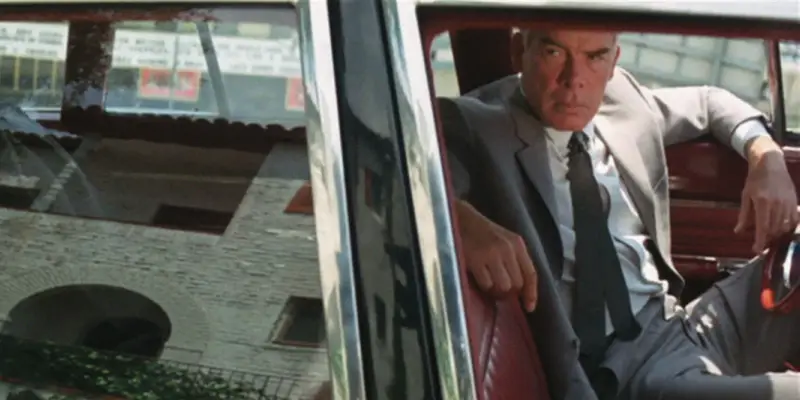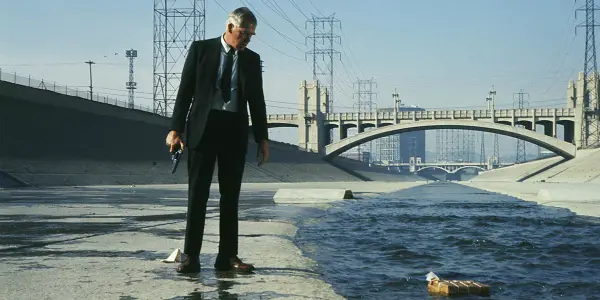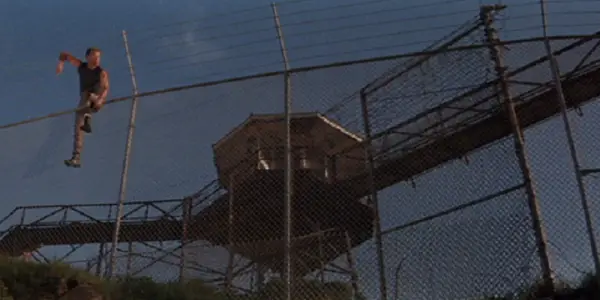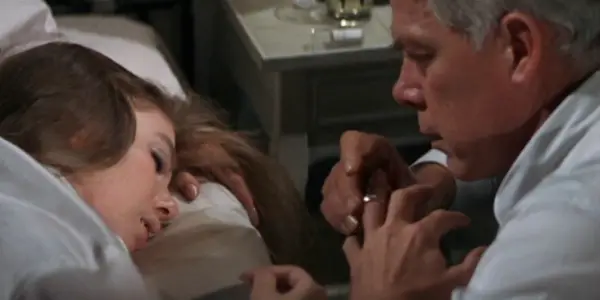POINT BLANK: Dissecting A Forgotten Classic

Alex is a 28 year-old West Australian who has a…
As soon as Justus D. Barnes fired point-blank at the audience in Edwin S. Porter’s influential The Great Train Robbery, the idea of violence to control an audience was introduced. The ricochet of that powerful shot has rung throughout the history of film, with violence becoming an extremely integral part of narrative storytelling.
It’s a cinematic weapon which can be used in a variety of different fashions to communicate plot, emotion and more. Whilst unknowingly, any director of any action film has been influenced by Edwin S. Porter’s game-changing decision, some directors have even gone out of their way to directly reference the famous confronting shot.
In Sam Peckinpah’s brilliant nihilistic drama Bring Me the Head of Alfredo Garcia, Peckinpah’s misanthropic middle finger to his outspoken detractors, features a drawn out gunfight which ends with a tight closeup with a gunshot blasting the screen. Peckinpah‘s telling us that violence has stayed the same, but it’s much more confronting and in your face, using Edwin S. Porter’s iconic visual to draw the point home.
With this in mind, we talk about John Boorman’s avant garde masterpiece Point Blank, a crime thriller which opens with a literal bang, setting up Boorman’s portrayal of violence within the film and immediately grabbing the audience’s attention with a stunning piece of sound design; one which harks back to the old school tactic of the horror jump scare: silence, false sense of security, and BANG!
An Outsider’s Vision
It has been shown repeatedly in cinema that a director working in foreign territory can bring brilliant results. Jules Dassin made Rififi in France, Canadian Ted Kotcheff made Australia’s best film with Wake in Fright, and Polish Roman Polanski made one of the definitive American noir films with Chinatown; these are just some of the examples of talented directors creating iconic films in foreign territories.
This is the case with the English director John Boorman creating the eclectic Point Blank in the United States, with the film being his American debut. At age 32, Boorman had his debut feature film with the documentary Catch Us if You Can.
A musical picture, Catch Us If You Can focused on The Dan Clark Five, purely made to capitalize on the success of Richard Lester’s successful Beatles film A Hard Day’s Night. Whilst not matching the commercial success of that film, the film scored enough critical success (including influential critic Pauline Kael), that it gave him a smooth transition into the film industry.

Boorman‘s American debut would come from acting legend Lee Marvin, who he initially met on the set of Marvin’s most well-known film, The Dirty Dozen. Marvin was interested in making an adaptation of Richard Stark’s novel The Hunter, but had been straddled with a terrible script that Marvin had hated.
Putting his trust on the unknown director, Marvin used his huge star power to gain control of casting and script approval, which he then gave to Boorman in complete trust, a risky move which gave the young director the power that most seasoned directors dream of. These pre-production stages just set-up the overall feel and structure for the film – experimental and putting faith in something new.
When the first cut of Point Blank was submitted, executives at Metro-Goldwyn-Mayer were obviously befuddled. Shocked at the film’s unconventional storytelling, they immediately ordered re-shoots and an entirely new edit, until it was luckily saved by Margaret Booth, an established editor and executive who starkly told them “You touch one frame of this film over my dead body!” Coupled with this and Marvin’s star power, the film was left untouched once released into mainstream audiences, where it received rave reviews from critics but lackluster box office reception.
Like most great films that fared poorly upon initial release, Point Blank has become a definitive cult classic, a film whose reputation has grown incredibly over the years due to its groundbreaking avant-garde techniques that it introduced into mainstream American cinema, and just for how incredibly unique it is.
A Modern Day Gangster Tale
When breaking down the plot of Point Blank, it sounds like a quite conventional neo-noir film, essentially a man vs the mob plot with the undercurrent of the worn-out revenge genre, fueled by the 1970’s nihilistic energy of the time. Lee Marvin stars as Walker (originally named Parker in the novel), a career criminal who is recruited by old friend Mal Reese (John Vernon) to intercept and rob the courier of a major underground gambling operation.
After the successful robbery within the abandoned Alcatraz prison, Reese double-crosses Walker, shooting him multiple times and leaving him for dead. Along with Walker’s wife Lynne (Sharon Acker), Reese escapes the island, using the money to pay back his debts to the mafia and rejoin them.
Walker somehow survives, making his way back to San Francisco, intent on getting revenge on Reese and stealing back his $93,000. Helped by the mysterious Yost (Keenan Wynn), Walker finds that getting his money back isn’t as easy as it seems – the mafia works within a corporation method, no-one has money anymore, and the world is much more complex than Walker remembers.
The most notable aspect of Point Blank is its dream-like erratic editing style, which gives the film its fluid European feel and delivers its narrative in an unconventional non-linear fashion. The film is delivered in a linear motion, yet the frequent flashbacks/callbacks to previous scenes gives quite a disorientating feeling that makes it feel like it is being delivered via clashing timelines.
The editing in Point Blank is extremely important, as the dream logic that it creates gives the film its mythical feeling. Usually in films, dream sequences are a cheap way for filmmakers to either explore a character’s psyche or backstory, as they allow the director to throw away any logic/basis of reality, allowing them to pull in any setting, character or prop without any organic setups or subtle storytelling. This is not the case here, and to highlight my point we should look at another film which nailed cinematic dream logic.

The other film is Herk Harvey’s Carnival of Souls, another movie which explores a protagonist who has escaped death and now exists in a hazy unreliable reality. Point Blank’s dream logic is backed up by the film’s plot – a simple revenge story where Lee Marvin tears through his enemies, surviving death and getting the ladies.
Whilst most pulpy B-Movies of the time just take that narrative material and deliver it straight, Point Blank takes it and in a post-modern fashion points at it and says “Hey, this really is an impossible male fantasy”. Due to this logic, Lee Marvin’s Walker becomes legend, an urban myth for the crime world, which is highlighted by the film’s ending as Walker simply disappears into the shadows.
This Is Marvin’s Movie
As seen in the film’s pre-production stages, Lee Marvin was an incredibly important factor in getting it made at all. Whilst most actors like to use their star power to fuel their personal passion projects, this film was much more personal for Marvin, who saw himself within the disillusioned character of Walker. This was something that Boorman caught onto early on, framing the film as a biographical study of Lee Marvin himself and his troubled post-World War II existence.
Marvin, like most old school tough guys in Hollywood, was an actor who enlisted in the military just as World War II was commencing. Just at the young age of 18, Marvin joined a marine division who were attacked during the assault on Mount Tapochau in the Battle of Saipan, a surprise attack that killed most of his team.
Whilst he received light wounds, he was medically discharged and sent home, which lead to his acting career. The survivor’s guilt caused by this experience haunted Marvin all his life, causing him to feel distanced from those around him and unable to fit into society within conventional methods.
This feeling of disillusionment and inability to connect to those around you due to a violent traumatic incident are the backbone behind Point Blank’s thematic content. John Boorman has frequently emphasised this interpretation of the film when commenting on Marvin’s past; “His whole platoon was wiped out, except for one other person. And he felt himself to be a coward lying there, and he never lost that. It was survival guilt – and it didn’t help that he had been shot in the arse. Not because he was running away, but because he was lying down when he was wounded.”
Looking Past the Film
The common interpretation of the bizarre journey of Point Blank is that we’re witnessing Walker’s death dream, with the idea that he died in Alcatraz prison and everything we see is a fantastical revenge fantasy dreamt by the dying protagonist. The film backs up this theory quite frequently with its narrative and stylistic choices, such as the impossibility of Walker surviving the gunshots and being able to swim back to shore, his lack of ability to communicate with those around him, and the disjointed narrative that frequently contradicts itself.
Whilst this is an interesting interpretation of the events depicted on-screen, it’s a theory that doesn’t quite give as much thematic depth to the film, boiling it down into an interesting visual experiment that plays with the tropes of the revenge genre. If you take the film literally and break down its perfect production design and use of setting, you start to understand the greater statement that Boorman is making about modern society and the plight of the everyday man within it.

The use of Alcatraz Prison is the film’s first sign of its thematic depth, as contextually the audience is aware that the prison is infamous for being inescapable. Even though the location is visually arresting and provides a unique setting to open on (it was the first film to use the location since its closure), knowing that it’s an impossible location to leave adds to the difficulty of Walker’s escape. It also gives a metaphorical look at the state of Walker himself – a man who has been robbed of freedom and who is stuck in the past.
An ordinary filmmaker would set the opening of Point Blank within an abandoned parking lot and shoot the same scenes, but this level of intelligent filmmaking highlights how advanced Boorman’s approach to the bald source material is. As Walker crosses the ocean (water usually being a metaphorical visual for birth/the cleansing of an unclean soul) and re-enters society, Walker finds himself cold to his surroundings.
Instead of just having the character say that out loud or through lazy exposition, Boorman, alongside his art directors Albert Brenner and George W. Davis, reflect that unsympathetic atmosphere through the striking production design and vivid colour palettes.
This intelligent use of production design continues throughout the film, as Walker’s new landscape is dominated by large and personality-less buildings, which highlight the shift from blue collar ingenuity keeping America alive to the growing dominance of faceless corporations. This takeover of vacant enterprises has bled over into the criminal world, with “The Organization” comprising of an ambiguous set of criminals who work professionally within buildings, subverting the common gangster stereotype of street level thugs who deal with physical money.
This introduces one of the main thematic concerns of the film, exploring modern society and the decreasing level of wealth for the modern man. Whilst on a surface level, Walker is merely looking for the money he feels he is deserved (like we all are), the problem isn’t that no-one wants to give Walker the money – it’s that no has money to give him.
In one of Point Blank‘s later scenes, Walker confronts one of the final men on his list, Brewster (Carrol O’Connor), who is exasperated that Walker has nearly collapsed the entire foundation of The Organization due to a lowly amount of $93,000. It’s quite a humorous scene, as Walker chiefly informs Brewster that yes, his revenge has all been for the money, nothing more, whilst Brewster reacts in utter shock.
Whilst this scene speaks to the pulpy nature of the film’s surface narrative, it also adds to its underlying message, that everyone projects a self-worth onto themselves, a level of financially and physical reward that we can never actually gain.
The Plight of the Modern Man
Walker represents the modern man in other ways, due to his quest for vengeance reflecting that of the normal civilian, who is sold the illusion of free will and the “American Dream”. Throughout the film, Walker is convinced he is a lone wolf in his quest for revenge, one man who is slowly unbuckling the system that screwed him over. This is what makes the film’s ending twist – that he has been manipulated by Yost (Keenan Wynn) the entire time to wipe out the Organization’s leaders – such an effective ending to Walker’s journey.
Walker causing so much disorder under the illusion of free will speaks to the plight of the modern man, thinking you have freedom to do whatever you want and live by your own rules, but trapped in a job in order to survive and constantly indulging in popular mainstream gratifications.
Stuck under the thumb of a faceless organization, Walker is merely another cog within a broken machine, hence why he disappears into the shadows at the end of the film. Walker recognises his misplacement in this new world and chooses to exit on his own terms, and he won’t let Yost (who represents these new corporations) control him.

Speaking of the Corporation and who they represent, who don’t dress and talk like the typical street thug that have become the go-to stereotype for any crime film, Boorman does have a deliberate look for them and their surroundings. One of the most visually attractive aspects of Point Blank comes from its clever costume design, which highlight what each character means and what they represent in the overall narrative.
Walker is introduced and starts off wearing neutral grey colours, as he is our protagonist and it’s his journey that we are witnessing onscreen. As Walker gets closer to his objective, his wardrobe and the production design around him shift towards more warmer colours. This shift is seen when Walker returns to his apartment initially, a boring, lifeless place with no colour to it, reflecting the emptiness of his character.
The Corporation itself, including its offices and employees, are all covered in different shades of green, a metaphorical symbol for money. Not only does the colour green signify money, it’s also seen as the colour for life, renewal and prosperity. These both represent on a physical and symbolic level what Walker is seeking the entire film – money (literally) and a new life (metaphorically).
As Walker closes in on in his money near the end of the story, he is donned in full orange and red colours, reflecting how close to the money he is. Walker’s sister-in-law Chris (Angie Dickinson) is dressed in a full golden wardrobe, a colour which covers her entire apartment. Gold symbolizes just that – gold or the physical manifestation of wealth. As Chris is Walker’s gateway towards his desired wealth, Boorman makes sure that even her appearance plays an important part in visually telling the story, not purely through exposition.
Lastly, we must touch on the Edwin S. Porter-inspired violence within this film and how it would itself go on to influence many more. Upon initial release, many critics were outraged by the film’s vigorous violence and escalating bloodshed, one notable mention by film critic Richard Schickel who condemned its “gratuitous violence”.
Point Blank is a key film within a pioneering decade of film; released in the same year as the hugely influential Bonnie and Clyde and The Dirty Dozen, it was very clear that the depiction of violence and its effect upon the audience was taking a much more graphic and nihilistic turn.
The switch from first person ambiguous gunfire in The Great Train Robbery had now evolved into witnessing a man being thrown off a building in full detail and the gory shoot-out deaths of Bonnie and Clyde. This shift is not only an aesthetic change in the evolution of cinema, but also reflects the changing values in American society.
The growing outrage of the Vietnam War (alongside the graphic footage of it shown constantly in the news) and slowly decaying Hollywood system allowed new filmmakers to come in and push the visual boundaries of American cinema, shepherding in the greatest and most experimental decade in cinematic history – the pioneering 1970’s.
Conclusion
Much like The Great Train Robbery, Point Blank has had a subtle but revolutionary impact on cinema, most notably the American crime genre and introducing French New Wave tactics into mainstream narratives.
The film’s notable scattershot editing was something shocking to witness in 1967, having the same mind-blowing effect on people that Bonnie and Clyde’s gory violence had or The Dirty Dozen’s indictment on religion, simple cinematic techniques that are taken for granted today. All crime films that followed Point Blank owe a debt to it, a film which pushed the boundaries visually and technically, informing us of the importance of artistic production design and the impact of onscreen violence.
Even this year, Tom Tykwer’s our review) borrows heavily from this film, with its use of frequent brief flashbacks and turbulent editing style. Weirdly, Point Blank tows the line between rightfully celebrated and criminally underrated, yet it is only usually talked about by old school filmmakers such as John Landis and Steven Soderbergh, an outspoken fan of it who made a very similar film with The Limey, a great little crime flick that was also criticised at the time of its release.
Visually arresting, incredibly intelligent and genuinely influential on the craft, John Boorman’s Point Blank deserves its title of being an American cinematic classic, a film which dared to push the boundaries of what could be done with the genre and doing so successfully, though sadly overshadowed by the mainstream success of Bonnie and Clyde. A violent punch to the face of generic crime cinema, Point Blank is one film that deserves a new generation of film-watchers to look back on, not only to reflect on its craft but also because it’s just damn entertaining.
What are your thoughs about Point Blank? Share them below.
Does content like this matter to you?
Become a Member and support film journalism. Unlock access to all of Film Inquiry`s great articles. Join a community of like-minded readers who are passionate about cinema - get access to our private members Network, give back to independent filmmakers, and more.













